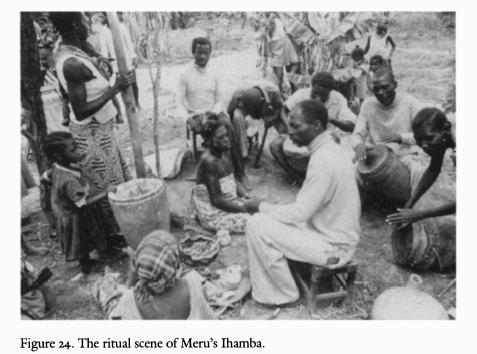Edith Turner Meets the Blob March 11, 2017
Author: Beach Combing | in : Contemporary , trackbackEdith Turner (deceased 2016) was a well-known British anthropologist. She is honoured here as a rogue researcher* for an experience in 1985 among the Ndembu in Central Africa. She was particularly interested in spirit healing and was allowed, at the very end of November of that year, to attend a healing ceremony where Meru, an ill fifty-five year old, would be cured. Meru can be glimpsed at the centre of the photograph. The local witch doctor, Singleton, had determined that there was a ihamba in Meru and this spirit beast had to be removed. Meru was made to prepare herself by putting red clay on her wrists. She was then brought to the ritual and thrown into a trance. Singleton’s task was to remove the ihamba that normally took the form of a human tooth, from Meru’s body, in this case from her back. This was presumably done by sleight of hand, but other matters are not so easily explained.
Clap, clap, clap – Mulandu was leaning forward, and all the others were on their feet – this was it. Quite an interval of struggle elapsed while I clapped like one possessed, crouching beside Bill amid a lot of urgent talk, while Singleton pressed Meru’s back, guiding and leading out the tooth. Meru’s face in a grin of tranced passion, her back quivering rapidly. Suddenly Meru raised her arm, stretched it in liberation, and I saw with my own eyes a giant thing emerging out of the flesh of her back. This thing was a large gray blob about six inches across, a deep gray opaque thing emerging as a sphere. I was amazed-delighted. I still laugh with glee at the realization of having seen it, the ihamba, and so big! We were all just one in triumph. The gray thing was actually out there, visible, and you could see Singleton’s hands working and scrabbling on the back, and then the thing was there no more. Singleton had it in his pouch, pressing it in with his other hand as well. The receiving can was ready; he transferred whatever it was into the can and capped the castor oil leaf and bark lid over it. It was done.
The tooth was in the can (actually a Vaseline jar), and the strange blob had disappeared, though hopefully not into any of the observers who had worn red clay to protect them: Edith had been warned that the ihamba could go back with her to her home in America. The tooth would be fed red meat in its jar and eventually disappear. Meru got better. Now what about that strange blob? In a note Edith writes ‘An opaque ‘plasma’ might describe it.’ The thing clearly made a huge impression on her.
Findings show that there exists a wide continuum between practitioners who take drugs continually in order to fall in a trance, and those who take none. I regard the events at Meru’s Ihamba as falling somewhere in between; some quality of the medicine did make me momentarily dizzy and may have triggered and liberated a rarely-used faculty-as rarely used as childbirth muscles, but none the less real. I repeat that I did not merely intuit the spirit form emerging from Meru’s back but saw it, saw it with my own eyes. This is different from intuition or imagination; it is nearer to seeing a ghost.
It would be interesting to know what the medicine was. Here is Edith’s rather offhand mention of it. What was it: drbeachcombing AT yahoo DOT com
Each drank a cupful of the leaf medicine; a cup was handed to me and I drank the liquid, which tasted pleasantly of fresh leaves. Immediately, my head fired up and swam. The drink contained no alcohol, but I felt the same recognizably loosening effect as before. Nevertheless I went on writing my field notes with no change in legibility.
These references all come from Edith’s Experiencing Ritual (1992). Note though that the ihamba changed Edith, perhaps it even took up residence within her. She would go on to have a series of psychic experiences in her anthropological work elsewhere and experimented with shamanic ritual: one of her most enjoyable accounts has her accidentally place a New York University student in a trance, who subsequently correctly predicted a Minnesota football game… Edith brought her back to earth with a rattle.
An evil afterthought: Ghostbusters came out in 1984.
*long term reader will know that this is not an insult, just a shocked nod to scholars who are eccentric enough to step outside the cardboard box that most academics, this blogger included, grope around in.



